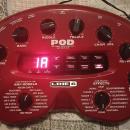Esto es lo que dice C. kinman:
"Basics: The distance between a string and magnet determines the loudness of the string so one might conclude that to get excellent balance of string outputs the magnets should all be the same distance from the strings. But fretboards are usually radiused (arched / cambered) and since the strings follow that radius we find magnets of different lengths arranged in an arc (ostensibly to match the arc of the strings). However, in practice some strings generate more output than others. For example the non-wound G string of modern string sets is mush louder than any other string, the B string also is somewhat louder while the D string is somewhat softer. That's why pickups have magnets of different lengths (staggered) to help compensate for the strings that are louder than others, so that all strings sound balanced.....ie they all have the same loudness. Another significant aspect of this story is that Leo Fender designed his fretboard radius for playing comfort, with a tight radius of 7-1/4", which is easy for fingers to form bar chords.
Problems: The traditional stagger of old Stratocasters was originally designed for a wound G string that was predominately used in the 50's and 60's. In the late 60's the Blues influenced musical styles and guitar players began stretching notes upwards by bending the strings. They soon discovered that a non-wound G string could be stretched (bent) far easier and further than a wound one. But a non-wound G string is a rogue and has dramatically more output and the increase in volume means it dominates all the other strings. It jumps out and can be heard as the loudest string, standing out dramatically in licks, runs and chords. This rogue string also misbehaves in terms of not oscillating at a stable frequency. And because of it's mass and low tension, it tends to succumb to the magnetic influence of the pickup and at elevated levels sounds akin to a chainsaw or buzzsaw. This is especially true with Class-A amps. This is actually a combination of the string crashing into the frets and frequency instability (Strat-itis). So we end up with a mix of Strat-itis and fret crash, I can't imagine anything more horrible and un-musical.This also translates into distortion sounds and, as with clean sounds, it is really quite objectionable and unpleasant (very un-musical). Pickup manufacturers never caught up to the modern style of playing and retained the old out of date stagger, many still to this day.
However a geometric problem exists with extreme stretching on Leo's 7-1/4" radius fretboard in that strings tend to bottom onto the frets resulting in choked (deadened) notes, particularily in the upper register. Players compared notes and noticed that flatter fretboards like Gibson's 11" radius did not have this choking problem. Realizing the advantages of a flatter radius some manufacturers (who were looking for a gimmick to increase market share) conceived the compound radius. Done sensibly, a compound radius is a clever way to combine the comfort of Leo's fretboards in the lower register with the aniti-choking properties of Gibson's fretboards in the upper register. However not all compound radius are sensible and some actually create another problem with string output imbalance. The result is the G string is excessively loud and the two E strings are excessively soft when vintage magnet staggers in the pickups are used. Using non-staggered magnets improves balance somewhat but still there is the big difference in output between the G and D strings as well as a significant difference to the other strings.
Solutions: One magnet stagger can't possibly match all the different fretboard radii options available on modern guitars (Kinman Tele pickup excepted, see Teles >additional info). Magnet staggers are set at time of manufacture and can not be changed, so to solve this dilemma I offer two radius options. First is the (fully compensated) stagger in the 7" to 14" radius range that suits most guitars (such as Fender, Musicman, G&L etc, see Table below). This can be ordered for non-wound and wound G strings.
NEW July-2008: The other is specifically designed to suit Warmoths 10-16" compound radius fretboard or any flatter fretboards ranging from 14" to 20" (see Table below). The Kinman flat radius stagger magnet array is engineered to compensate the D and G strings for balanced output with all other strings. It's a perfect solution and is much better than regular non-staggered magnets.
Conclusion: Warmoths 10-16 compound radius is excessive but now Kinman offers a solution. However USA Custom Guitars make a sensible compound radius 7-1/4" to 9-1/2" that works great with staggered poles, is comfortable and solves choking, the perfect soultion. For more discussion about fretboard radius visit my Perfect Guitar page, fretboard radius section.
NOTE: When a wound G string is used with a magnet designed for non-wound string the wound string will have significantly lower output. If you contemplate alternating both types of string it's better to choose a stagger for wound G string. When you are using the non-wound string it will be louder than the others but that is preferable to one that has lower output.
Special note about Jimi's Reverse Stagger: I believe Jimi got his sounds in spite of the reverse stagger and that he just learned to live with it. So I do not recommend a reverse stagger to emulate Jimi's sound. All this does is lower the output of the A string and that's definitely not very pleasing. If you want to emulate Jimi's sound you will be thrilled with the Woodstock's performance and once you hear them you won't regret not getting Jimi's reverse stagger, I promise you.
The radius range is marked on the base of the pickups as well as on the label in the box. The table below gives you a rough guide as to the radius of some common guitars. If your's is not listed please "Contact Me" to have it included on this page
- RADIUS CHART -
All radius can be supplied in either Right or Left hand.
RANGE range in inches BRANDS and MODELS
Improved stagger
7" - 14"
All Strats* including those with Floyd Rose bridges, Japanese Squiers*, G&L, Fernandez, Tokai, Korean Squiers, Musicman, Yamaha Pacificia (standard) and most other guitars with traditional bridges. Not PRS bolt on neck models.
Non-staggered
15" - 20" Warmoth 10"-16" compound,
Yamaha Pacificia (only their compound neck),
Parker Fly: check Parker website >Resourses >Specifications >Model >Fretboard shape (most seem to be either 10"-13" or 10"-15")
Bill Lawrence.
Check your radius, if you're not sure what it is, better shops and good repairmen quite often have radius gauges that can measure this. If you prefer to measure it yourself, download the instructions and templates below.
"Basics: The distance between a string and magnet determines the loudness of the string so one might conclude that to get excellent balance of string outputs the magnets should all be the same distance from the strings. But fretboards are usually radiused (arched / cambered) and since the strings follow that radius we find magnets of different lengths arranged in an arc (ostensibly to match the arc of the strings). However, in practice some strings generate more output than others. For example the non-wound G string of modern string sets is mush louder than any other string, the B string also is somewhat louder while the D string is somewhat softer. That's why pickups have magnets of different lengths (staggered) to help compensate for the strings that are louder than others, so that all strings sound balanced.....ie they all have the same loudness. Another significant aspect of this story is that Leo Fender designed his fretboard radius for playing comfort, with a tight radius of 7-1/4", which is easy for fingers to form bar chords.
Problems: The traditional stagger of old Stratocasters was originally designed for a wound G string that was predominately used in the 50's and 60's. In the late 60's the Blues influenced musical styles and guitar players began stretching notes upwards by bending the strings. They soon discovered that a non-wound G string could be stretched (bent) far easier and further than a wound one. But a non-wound G string is a rogue and has dramatically more output and the increase in volume means it dominates all the other strings. It jumps out and can be heard as the loudest string, standing out dramatically in licks, runs and chords. This rogue string also misbehaves in terms of not oscillating at a stable frequency. And because of it's mass and low tension, it tends to succumb to the magnetic influence of the pickup and at elevated levels sounds akin to a chainsaw or buzzsaw. This is especially true with Class-A amps. This is actually a combination of the string crashing into the frets and frequency instability (Strat-itis). So we end up with a mix of Strat-itis and fret crash, I can't imagine anything more horrible and un-musical.This also translates into distortion sounds and, as with clean sounds, it is really quite objectionable and unpleasant (very un-musical). Pickup manufacturers never caught up to the modern style of playing and retained the old out of date stagger, many still to this day.
However a geometric problem exists with extreme stretching on Leo's 7-1/4" radius fretboard in that strings tend to bottom onto the frets resulting in choked (deadened) notes, particularily in the upper register. Players compared notes and noticed that flatter fretboards like Gibson's 11" radius did not have this choking problem. Realizing the advantages of a flatter radius some manufacturers (who were looking for a gimmick to increase market share) conceived the compound radius. Done sensibly, a compound radius is a clever way to combine the comfort of Leo's fretboards in the lower register with the aniti-choking properties of Gibson's fretboards in the upper register. However not all compound radius are sensible and some actually create another problem with string output imbalance. The result is the G string is excessively loud and the two E strings are excessively soft when vintage magnet staggers in the pickups are used. Using non-staggered magnets improves balance somewhat but still there is the big difference in output between the G and D strings as well as a significant difference to the other strings.
Solutions: One magnet stagger can't possibly match all the different fretboard radii options available on modern guitars (Kinman Tele pickup excepted, see Teles >additional info). Magnet staggers are set at time of manufacture and can not be changed, so to solve this dilemma I offer two radius options. First is the (fully compensated) stagger in the 7" to 14" radius range that suits most guitars (such as Fender, Musicman, G&L etc, see Table below). This can be ordered for non-wound and wound G strings.
NEW July-2008: The other is specifically designed to suit Warmoths 10-16" compound radius fretboard or any flatter fretboards ranging from 14" to 20" (see Table below). The Kinman flat radius stagger magnet array is engineered to compensate the D and G strings for balanced output with all other strings. It's a perfect solution and is much better than regular non-staggered magnets.
Conclusion: Warmoths 10-16 compound radius is excessive but now Kinman offers a solution. However USA Custom Guitars make a sensible compound radius 7-1/4" to 9-1/2" that works great with staggered poles, is comfortable and solves choking, the perfect soultion. For more discussion about fretboard radius visit my Perfect Guitar page, fretboard radius section.
NOTE: When a wound G string is used with a magnet designed for non-wound string the wound string will have significantly lower output. If you contemplate alternating both types of string it's better to choose a stagger for wound G string. When you are using the non-wound string it will be louder than the others but that is preferable to one that has lower output.
Special note about Jimi's Reverse Stagger: I believe Jimi got his sounds in spite of the reverse stagger and that he just learned to live with it. So I do not recommend a reverse stagger to emulate Jimi's sound. All this does is lower the output of the A string and that's definitely not very pleasing. If you want to emulate Jimi's sound you will be thrilled with the Woodstock's performance and once you hear them you won't regret not getting Jimi's reverse stagger, I promise you.
The radius range is marked on the base of the pickups as well as on the label in the box. The table below gives you a rough guide as to the radius of some common guitars. If your's is not listed please "Contact Me" to have it included on this page
- RADIUS CHART -
All radius can be supplied in either Right or Left hand.
RANGE range in inches BRANDS and MODELS
Improved stagger
7" - 14"
All Strats* including those with Floyd Rose bridges, Japanese Squiers*, G&L, Fernandez, Tokai, Korean Squiers, Musicman, Yamaha Pacificia (standard) and most other guitars with traditional bridges. Not PRS bolt on neck models.
Non-staggered
15" - 20" Warmoth 10"-16" compound,
Yamaha Pacificia (only their compound neck),
Parker Fly: check Parker website >Resourses >Specifications >Model >Fretboard shape (most seem to be either 10"-13" or 10"-15")
Bill Lawrence.
Check your radius, if you're not sure what it is, better shops and good repairmen quite often have radius gauges that can measure this. If you prefer to measure it yourself, download the instructions and templates below.








